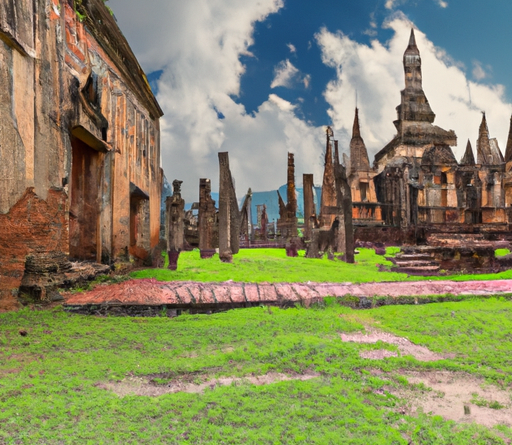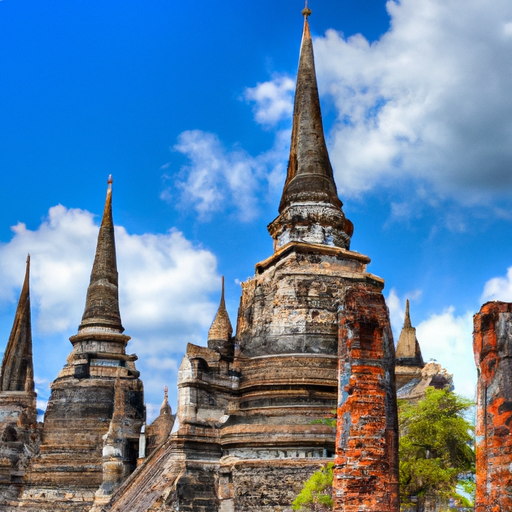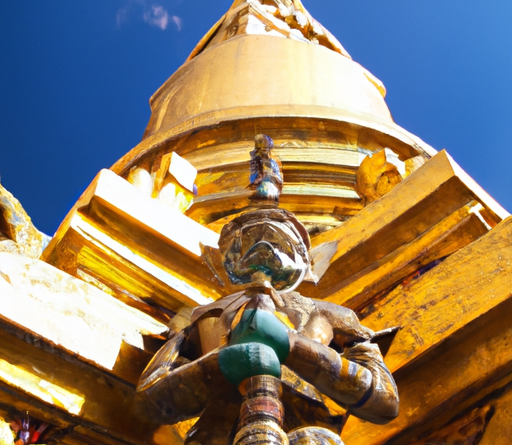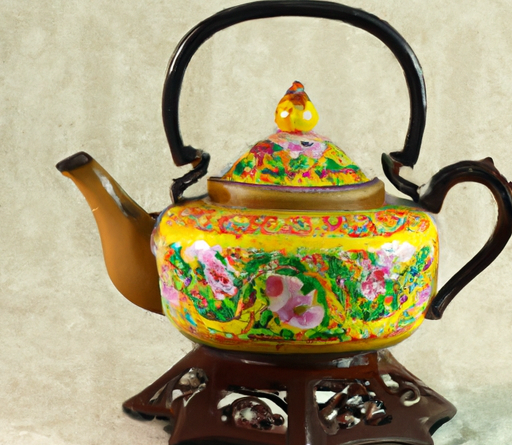
Thailand is a treasure trove of cultural and historical wonders, and exploring its UNESCO Heritage Sites is like stepping into a world filled with ancient temples, breathtaking landscapes, and rich traditions. With our comprehensive guide, you will be able to unravel the secrets of these incredible sites, from the majestic ruins of Ayutthaya to the stunning natural beauty of Sukhothai. Whether you are a history buff, a nature lover, or simply seeking a unique travel experience, Thailand’s UNESCO Heritage Sites offer something for everyone. So pack your bags, immerse yourself in the vibrant Thai culture, and get ready for a journey of a lifetime.
Overview of UNESCO Heritage Sites in Thailand
Thailand, a country rich in cultural and natural treasures, is home to numerous UNESCO World Heritage Sites. These sites are recognized for their outstanding universal value and are carefully protected and preserved by the Thai government. From ancient cities to stunning national parks, Thailand’s UNESCO Heritage Sites offer a glimpse into the country’s rich history and breathtaking natural beauty.
What are UNESCO Heritage Sites?
UNESCO Heritage Sites are places of exceptional cultural or natural significance that have been recognized by the United Nations Educational, Scientific and Cultural Organization (UNESCO). These sites are considered to be of universal value and are considered crucial for the preservation and promotion of human heritage. Thailand is proud to have several UNESCO Heritage Sites that showcase the country’s unique history, architecture, and natural resources.
Importance of UNESCO Heritage Sites
UNESCO Heritage Sites hold immense cultural, historical, and ecological importance. They act as symbols of pride and identity for the people of the country in which they are located. These sites not only preserve and promote cultural heritage but also contribute to sustainable development by attracting tourists from around the world. They serve as educational platforms for visitors to learn about different civilizations, traditions, and ecosystems, thus fostering global understanding and appreciation.
Number of UNESCO Heritage Sites in Thailand
Thailand boasts a total of 6 UNESCO World Heritage Sites, each offering a unique experience and insight into the country’s past and present. These sites are spread across different regions, reflecting the diversity and richness of Thailand’s heritage.
Northern Region
Historic City of Ayutthaya
The Historic City of Ayutthaya is one of Thailand’s most iconic UNESCO Heritage Sites. Once the capital of the Kingdom of Siam, Ayutthaya was a thriving city until its destruction in the 18th century. Today, visitors can explore the ancient temples, palaces, and sculptures that tell the story of this magnificent city’s past.
Historic Town of Sukhothai and Associated Historic Towns
The Historic Town of Sukhothai and its Associated Historic Towns are another must-visit destination in Thailand. Sukhothai was the capital of the Kingdom of Sukhothai, which flourished in the 13th and 14th centuries. The site showcases the architectural grandeur of the era, with its majestic temples and Buddha statues.
Historic Town of Phra Nakhon Si Ayutthaya and Associated Historic Towns
Located in the central part of Thailand, the Historic Town of Phra Nakhon Si Ayutthaya and its Associated Historic Towns are a treasure trove of ancient ruins and cultural heritage. The site features impressive temples, palaces, and statues that transport visitors back in time to the golden era of the Ayutthaya Kingdom.
Central Region
Ban Chiang Archaeological Site
The Ban Chiang Archaeological Site in the central region of Thailand is an archaeological marvel that dates back thousands of years. It is one of the most important prehistoric settlements in Southeast Asia and showcases the unique pottery, bronze artifacts, and ancient burial grounds of the early civilization that once inhabited the area.
Historic City of Bangkok
The Historic City of Bangkok, the bustling capital of Thailand, is a vibrant mix of modernity and history. While the city is known for its modern skyscrapers and bustling streets, it is also home to several historic landmarks, including the Grand Palace and Wat Phra Kaew, which are recognized as part of the UNESCO World Heritage Site.
Historic City of Ayutthaya
As mentioned earlier, the Historic City of Ayutthaya also falls under the central region of Thailand and is a UNESCO World Heritage Site worth exploring. Its proximity to Bangkok makes it a popular day trip destination for tourists looking to immerse themselves in Thailand’s rich history and architectural wonders.
Northeastern Region
Ban Chiang Archaeological Site
The Ban Chiang Archaeological Site also extends to the northeastern region of Thailand, showcasing its significance and widespread impact. The site highlights the cultural heritage and ancient craftsmanship of the early Thai civilizations, making it a valuable addition to Thailand’s UNESCO World Heritage Sites.
Historic City of Ayutthaya
The Historic City of Ayutthaya is not limited to the northern and central regions but also extends to the northeastern region of Thailand. This demonstrates the historical, cultural, and architectural significance of Ayutthaya, which continues to captivate visitors from across the globe.
Historic Town of Sukhothai and Associated Historic Towns
Similarly, the Historic Town of Sukhothai and its Associated Historic Towns can also be found in the northeastern region. The UNESCO World Heritage Site boasts an enchanting mix of art, history, and spirituality, attracting visitors who are in search of a deep connection with Thailand’s ancient past.
Eastern Region
Thungyai-Huai Kha Khaeng Wildlife Sanctuaries
The Thungyai-Huai Kha Khaeng Wildlife Sanctuaries located in the eastern region of Thailand bring forth the country’s commitment to preserving its natural wonders. These sanctuaries are home to diverse flora and fauna, including endangered species such as tigers and elephants, making it an incredible destination for wildlife enthusiasts.
Dong Phayayen-Khao Yai Forest Complex
The Dong Phayayen-Khao Yai Forest Complex is another UNESCO World Heritage Site in the eastern region, known for its immense biodiversity and intact ecosystems. The area encompasses lush forests, waterfalls, and unique wildlife, offering visitors a chance to reconnect with nature in its purest form.
Historic Town of Sukhothai and Associated Historic Towns
The Historic Town of Sukhothai and its Associated Historic Towns are not confined to the northern and central regions but stretch to the eastern region as well. This highlights the historical and cultural significance of Sukhothai, making it a prominent UNESCO World Heritage Site worth exploring.
Southern Region
Hat Chao Mai National Park
In the southern region of Thailand lies the Hat Chao Mai National Park, a pristine coastal area that is celebrated for its stunning natural beauty. With its white sandy beaches, crystal-clear waters, and diverse marine life, the park provides a protected habitat for numerous species and offers visitors a chance to experience the exquisite beauty of Thailand’s southern coast.
Kaeng Krachan Forest Complex
The Kaeng Krachan Forest Complex, situated in the southern region, is the largest national park in Thailand and a UNESCO World Heritage Site. This vast expanse of tropical rainforest is home to an abundance of plant and animal species, including elephants, tigers, and rare birds. Visitors can explore its trails, visit picturesque waterfalls, and immerse themselves in the unspoiled natural wonders of Thailand.
Phong Nha-Ke Bang National Park
Located in the Trang An Scenic Landscape Complex, Phong Nha-Ke Bang National Park is a treasure trove of natural wonders in the southern region of Thailand. The park is renowned for its extensive cave system, including the world’s largest cave, Son Doong. Visitors can marvel at the stunning limestone formations, embark on adventurous cave explorations, and enjoy the breathtaking beauty of this UNESCO World Heritage Site.
Criteria for UNESCO World Heritage Sites
UNESCO World Heritage Sites are chosen based on specific criteria that assess their cultural or natural significance. These criteria serve as guidelines for evaluating the value and integrity of the nominated sites. UNESCO distinguishes between cultural, natural, and mixed sites, each requiring different criteria to meet the standards of universal value.
Cultural Criteria
Cultural sites must demonstrate outstanding universal value by representing a masterpiece of architecture, exhibiting exceptional human creativity, preserving an important cultural tradition, or offering unique insights into the past civilizations.
Natural Criteria
Natural sites are selected based on their exceptional beauty, geological significance, or outstanding ecological processes. These sites showcase the diversity and importance of the Earth’s natural systems, offering exceptional opportunities for scientific research and environmental education.
Mixed Criteria
Mixed sites possess a combination of cultural and natural values, combining the importance of both aspects into a single World Heritage Site. These sites are recognized for their outstanding universal value and their ability to connect cultural and natural heritage.
Efforts to Preserve and Protect UNESCO Heritage Sites
Preserving and protecting UNESCO Heritage Sites is of paramount importance to Thailand. The Thai government, in collaboration with various organizations, has implemented several measures to ensure the sustainable conservation of these precious sites.
Management Plans
Thailand has developed comprehensive management plans that outline strategies for the preservation, restoration, and sustainable development of its UNESCO Heritage Sites. These plans involve the participation of local communities, cultural experts, and environmental organizations to ensure effective management and long-term sustainability.
Conservation Programs
Thailand has established conservation programs dedicated to the preservation of its UNESCO Heritage Sites. These programs focus on activities such as site monitoring, artifact preservation, restoration of historical structures, and environmental conservation. They also promote awareness and education to foster a sense of responsibility and appreciation among visitors and local communities.
Tourism and Sustainable Development
Thailand recognizes the potential of responsible tourism in promoting the preservation and development of its UNESCO Heritage Sites. The Thai government encourages sustainable tourism practices that minimize negative impacts on the sites and maximize the benefits for local communities. Tourism activities are carefully regulated to ensure the protection of cultural heritage, natural ecosystems, and the well-being of the local population.
Challenges in Preserving UNESCO Heritage Sites in Thailand
Preserving UNESCO Heritage Sites in Thailand is not without its challenges. These important cultural and natural treasures are vulnerable to various threats, and addressing these challenges is crucial to ensure their long-term sustainability.
Urbanization and Development
The rapid urbanization and development taking place in Thailand pose a significant challenge to the preservation of its UNESCO Heritage Sites. Encroachment, infrastructure development, and changing land use patterns can have detrimental effects on the integrity and authenticity of these sites. Balancing the need for development and the protection of heritage requires careful planning and collaboration between various stakeholders.
Commercial Exploitation
Commercial exploitation can also threaten the preservation of UNESCO Heritage Sites. Uncontrolled tourism, excessive development of tourist facilities, and unauthorized trading of artifacts can degrade the sites and harm their cultural and ecological significance. Effective regulation, monitoring, and enforcement are essential to combat these practices and ensure the sustainable development of these sites.
Environmental Degradation
Environmental degradation, including pollution, deforestation, and climate change, poses a significant threat to the integrity of Thailand’s UNESCO Heritage Sites. These sites are part of delicate ecosystems that require protection and conservation. Implementing strong environmental policies, promoting sustainable practices, and raising awareness about environmental issues are key to mitigating these challenges.
Tips for Visiting Thailand’s UNESCO Heritage Sites
Visiting Thailand’s UNESCO Heritage Sites is a unique and enriching experience. To make the most of your visit and contribute to the preservation of these sites, it is essential to follow some simple tips:
Research and Plan Ahead
Before visiting any UNESCO Heritage Site, conduct thorough research to understand its significance, history, and any specific regulations or guidelines that apply. Plan your visit accordingly, considering factors such as weather conditions, opening hours, and visitor restrictions.
Respect Local Culture and Customs
When exploring UNESCO Heritage Sites, it is important to be respectful of local culture and customs. Dress modestly, behave appropriately, and follow any guidelines or instructions provided by site authorities. Show reverence for religious sites and artifacts and refrain from any actions that may cause damage or disrespect.
Follow Sustainable Tourism Practices
Practice responsible and sustainable tourism at all times. Minimize your environmental impact by disposing of waste properly, avoiding the use of single-use plastics, and supporting local businesses and communities. Be mindful of the flora and fauna within the sites, refraining from littering or disturbing the natural environment.
By following these tips and approaching your visit with a sense of curiosity, respect, and responsibility, you can contribute to the preservation and protection of Thailand’s UNESCO Heritage Sites while creating lasting memories in this remarkable country.






